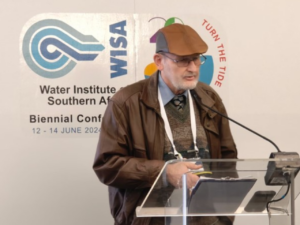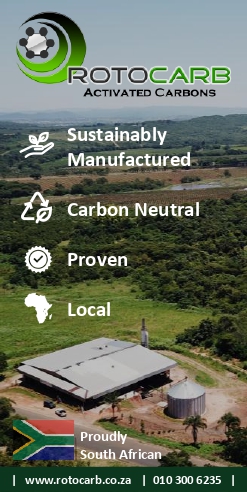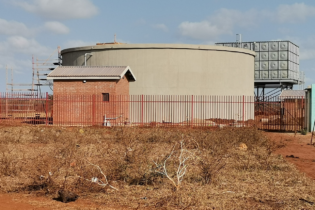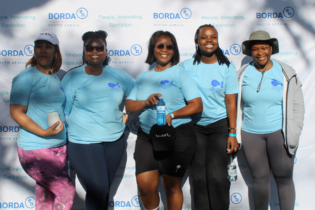Jürgen Menge, a recent recipient of the WISA senior fellow award, talks about his career and involvement in the world's first potable water reclamation plant.
Menge grew up on a farm near Grootfontein, Namibia, and studied at the University of Stellenbosch on a bursary.
“I was a ‘social academic student’ and took six years to complete my Bachelor of Science (BSC) degree – one year for academics, one year for social activities, and so on. I played soccer, took part in mountain climbing and boxing, enjoyed partying, and unfortunately did not whole-heartedly focus on academics. When I applied to do an Honours degree, my lecturer advised that I start to work instead,” states Menge.
Membrane research
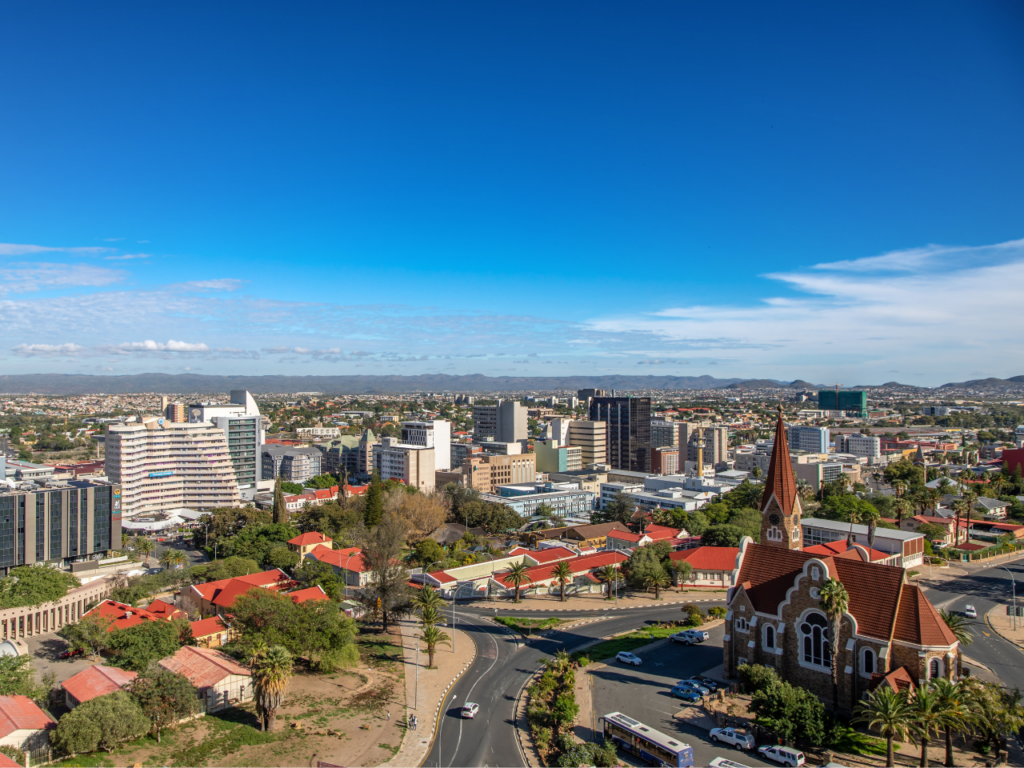
Surface and groundwater could not sustain Windhoek
Fortunately, during those six years, Menge did part-time work with the then Dr Ron Sanderson, who was involved in membrane research and would later become a well-respected professor in polymer chemistry. At the time, the
Water Research Commission (WRC) was developing membrane rigs and focusing on mechanics at the
Durban Technical University, while Stellenbosch University was working on the chemistry side doing the membrane research. Ed Jacobs (later Professor Jacobs) was completing his Phd and was working under Dr Sanderson.
“I worked under Ed Jacobs as a student research employee. We had a large research team of 12 and 15 students, who were either undergrads or working on their MSc or Phd. I met some extremely clever people among them and developed a love for research in the membrane field,” adds Menge.
On completion of his degree, Menge took his lecturer’s advice to heart and started to look for a job.
“I promised to give a bottle of brandy to the person at Polymer Chemistry who would provide me with a solid job advertisement. This happened within three weeks. I applied for a microbiologist position advertised by the City of Windhoek and was successful. The City of Windhoek employed me for the next 35 years, during which I was promoted from microbiologist to chief scientist.”
First water reclamation plant in the world
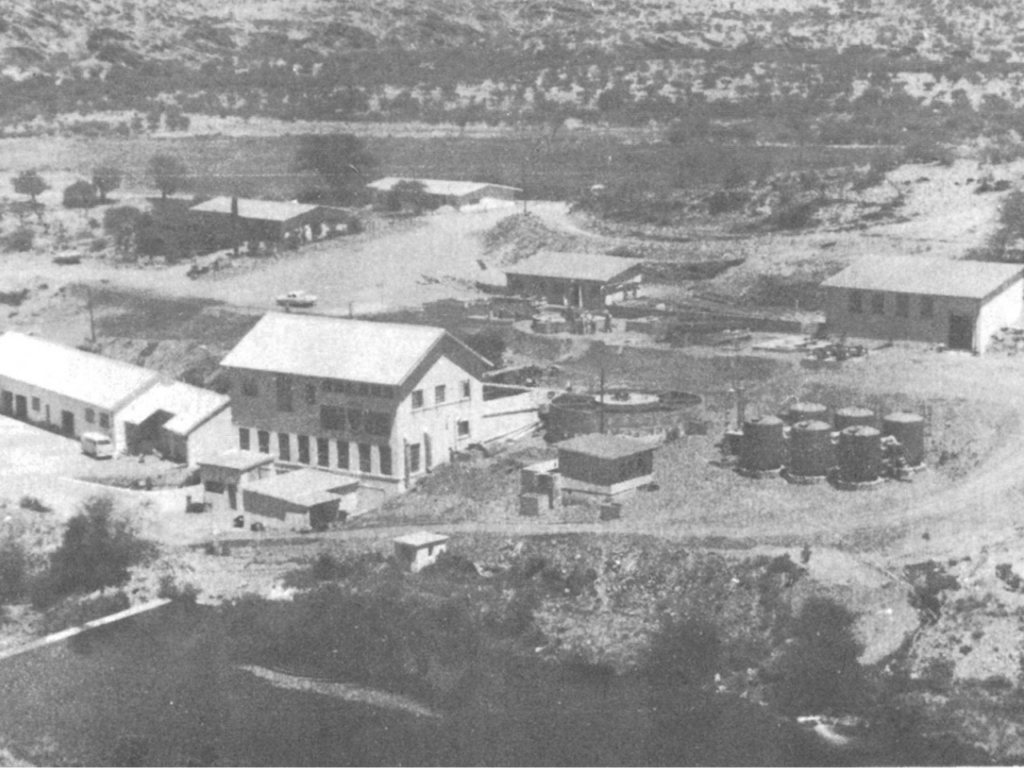
Old Goreangab Water Reclamation Plant Mark I 1968-1976 with a capacity 4.8 Mℓ/d
Working for the Windhoek Municipality proved to be a positive experience for Menge. Windhoek became the first city in the world to produce drinking water directly from municipal wastewater.
The original
Goreangab Water Reclamation Plant in Windhoek was developed by the
National Institute for Water Research (NIWR) of the Council for Scientific and Industrial Research (CSIR) during the 1960s. The design and operation was based on the results of a pilot plant operated by the NIWR in Windhoek over the period 1964 to 1968 located at the Gammams Wastewater Treatment Plant.
In 1971, the WRC immediately embarked on an ambitious research programme at the Stander Reclamation Demonstration Plant in Pretoria, to expedite the development of the technology of water reclamation and to study the health effects of such water. Successful research was then implemented in Windhoek. In 1976 the Windhoek plant was upgraded and extended.
At the inauguration ceremony Dr Stander, chairman of the WRC, stressed the significance and the value of the ground-breaking research at Windhoek. “In this same year that saw science and engineering land a human on the face of the moon, science and engineering also brought direct water reuse into reality. The question is, which event will have more intimate impact on our lives and those of our children?”
Importance of reclamation to Windhoek
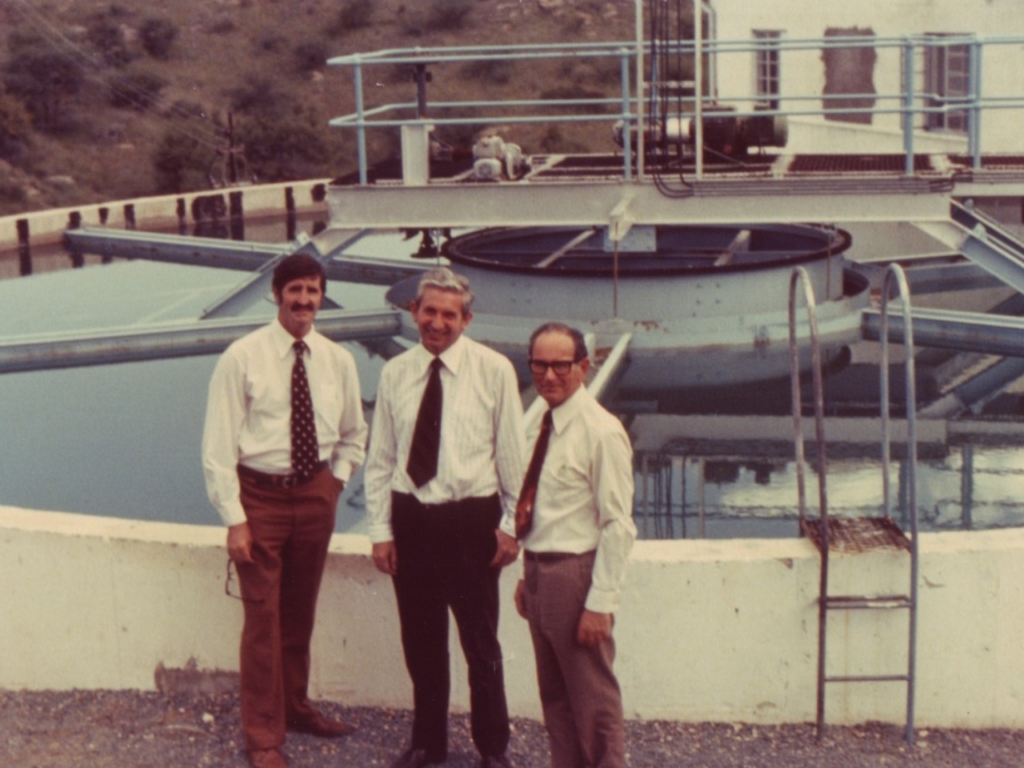
Inauguration of the first reclamation plant in 1969
In 1988 Namibia prepared for its independence and with that the WRC, the CSIR, and the Department of Health all withdrew from Namibia. This meant that all the research and quality monitoring responsibility fell on the technical staff of the City of Windhoek.
“I wasn’t senior enough to attend the final meeting, but during that final meeting between us and the organisations leaving Namibia it was identified that Windhoek would run out of water in the year 1990,” explains Jürgen.
This prediction was accurate. Namibia is the driest country in southern Africa, receiving an average of 280 mm of rain each year, 83% of which is lost to evaporation and a further 14% absorbed by plants. Namibia experienced severe drought events in the early 1990s. It became clear that surface and groundwater could not sustain Windhoek. The only solution available was to increase the reclamation capacity of the Goreangab plant. That decision was taken during a strategic meeting with the Department of Water Affairs in 1992. In 1994 the capacity of the plant was extended from 7.2 Mℓ/d to 14.4 Mℓ/d. This upgrade treated dam and wastewater in one process train. Until then there had been two separate treatment trains.
Fortunately, Namibia still received substantial technical support and assistance from international sources for its water reclamation efforts. Even though Namibia was independent from South Africa, both the CSIR and WRC still worked closely with Namibia due to the strategic importance of water reuse. “When looking back at all the work done at the Goreangab Water Reclamation Plant, it was a huge team effort. No one can say ‘I did this’, including myself, it was a large group of us working together. I was fully devoted to the project but so were many others,” explains Menge.
New processes
In 1987 Prof Willi Grabow advised Menge to study for an honours degree in Water Utilisation at the
University of Pretoria, under the late Professor At Pretorius. Although he never completed the course, he was able to connect with experts across the water sector and discovered new technologies for water reclamation. This was a turning point in Jürgen’s career. Prof Grabow taught him an important lesson: personal knowledge is limited, being well connected provides unlimited access to knowledge.
“It was an exciting part of my career, where I was part of what I call the second generation of researchers working on water reclamation. The first generation built the foundation, but the second generation of researchers had to go beyond simply maintaining the original research.”
Since the commissioning of the first reclamation plant in 1968, a huge amount of new information on various aspects of water treatment became known. During these years the experience of the various experts and engineers was documented and published by the Water Research Commission in two separate manuals. Experience obtained from the old plant, information from pilot plant studies and knowledge of current technologies had to be integrated into a process design for the new plant.
Menge explains that the original plant was expensive to operate. “Adjustments were needed to make the plant economically viable. For instance, there were a number of chlorination steps in the process. The greater the concentration of organics in the water, the greater the chlorine demand. We were originally using between 12 and 14 mg/ to achieve a free chlorine residual. The water was chlorinated after the primary settling, dissolved air flotation and sand filtration, and finally after activated carbon filtration. We moved all that after activated carbon filtration and made it double chlorination step with breakpoint chlorination.”
To save money, the team concentrated on the removal of organics before activated carbon filtration, by introducing enhanced coagulation and improving dissolved air flotation under the guidance of Prof Haarhoff. Changing the process of the water plant was radical at the time. Visiting professors were shocked to hear that the Windhoek team took almost all the chlorination out of the process to reduce the chlorine demand and concentrated it at the end of the process. But Menge adds,
“They did all come around and support us, once they saw what we were doing and the positive results it produced.” The savings in chlorine helped to stabilise the water budget. There was no need to increase the budget for chemicals for the following two to three years with this plan, making the plant more economically efficient. An additional benefit was that the trihalomethane concentration levels decreased considerably.
Bacteria, viruses and parasites
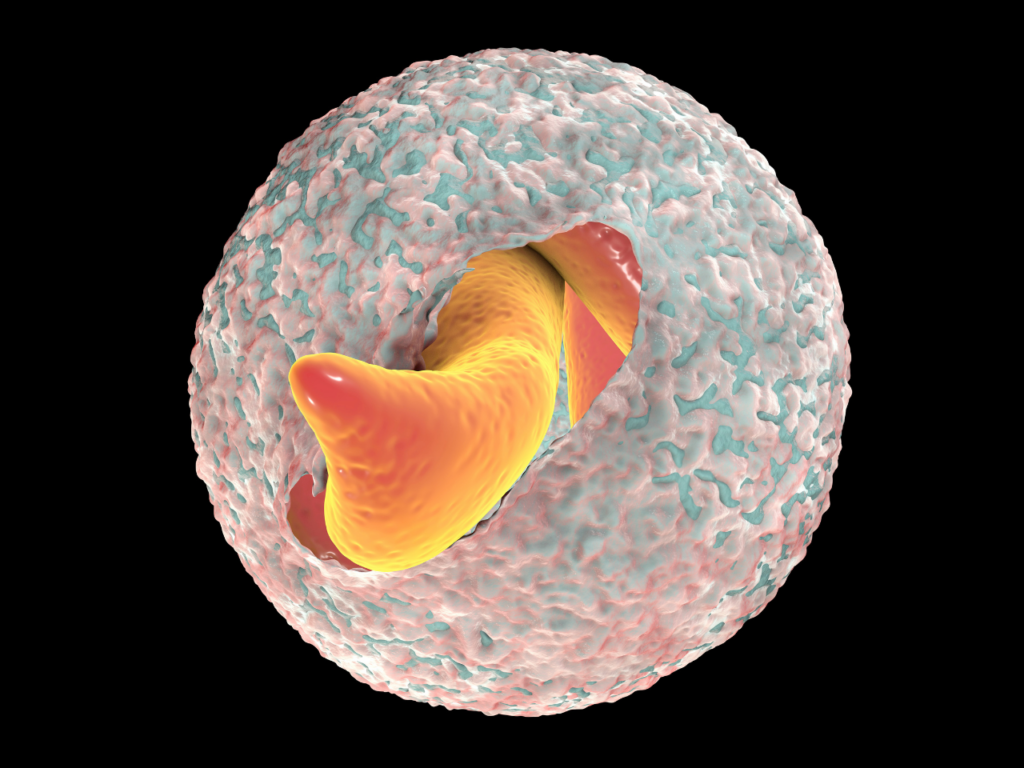
Illustration of Cryptosporidium
Part of ensuring that the reclamation plant was a success was testing to see if the water coming out of the plant could be blended with other streams of water while maintaining its safe standard. In this case, the plant was fed from two sources, these being the Gammams Sewage Treatment Plant and the Goreangab Dam. The raw waters were then mixed and blended and treated as a single stream. In general, the objective was to utilise a larger portion of the effluent from the sewage treatment plant than water from the Goreangab Dam.
“In 1992, for the first time, a virus was detected in the final water. This was due to contaminated water from the Goreangab Dam. Early rainfall brought dirt and organic matter into the dam, and that resulted in an algae bloom increasing the pH levels of the water above 9.2. We were using aluminium sulphate at the time,” explains Menge.
He adds that the high pH of the water coming into the plant impeded flocculation and the aluminium molecules formed a gel that shielded the viruses in the water.” This led us to use ferric chloride as coagulant instead which can handle a broader pH range. We could not afford to not treat the Dam water, as we needed every drop.”
This research and adjusted chemical process resulted in a single process for the reclamation and dam water, forgoing the dual process and streamlining the treatment producing a more effective and robust treatment method for Windhoek.
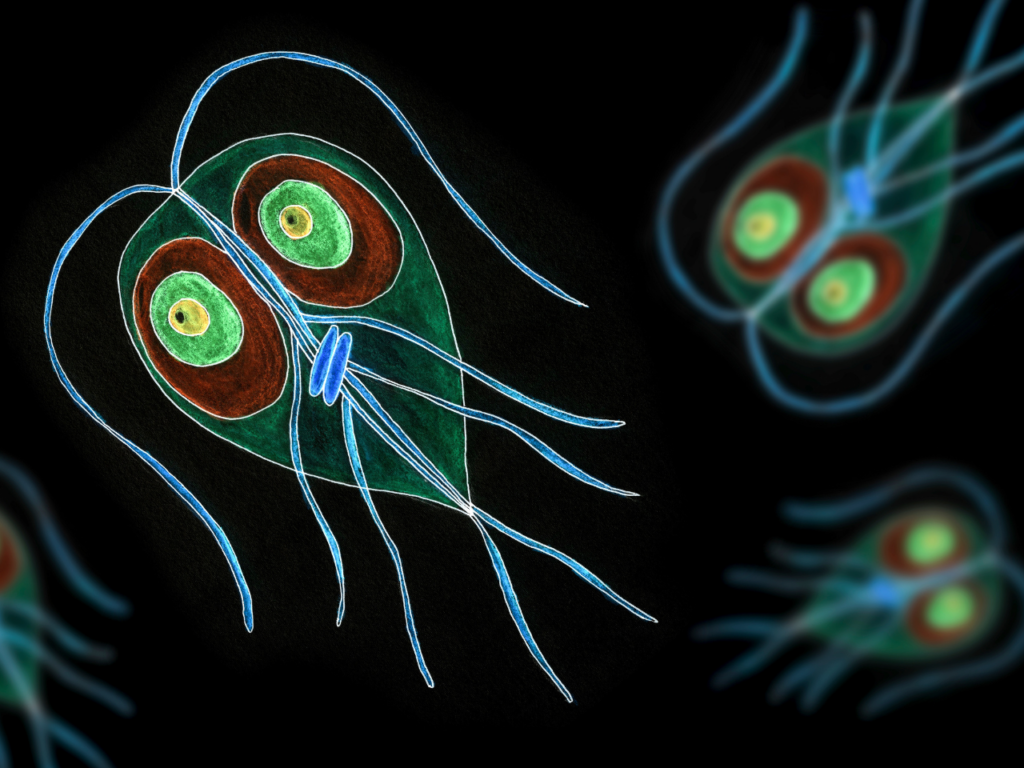
Illustration of Giardia
“In 1994, we began to isolate Giardia and Cryptosporidium and send these samples to the CSIR. This now proved to be a new problem. A course I attended at the University of Pretoria under guidance of Professor Hans van Leeuwen came in handy. I learned that ozonation was an alternative treatment to oxidise organics and make them biologically available and additionally act as a disinfectant for Giardia.”
Professor Hans van Leeuwen assisted Windhoek with the initial ozone research in 1992. Ozone is the oxygen-rich O
3 molecule, with high oxidative power, which when added to water helps to purify it. Ozonation can help clear water from parasites by disrupting the cell-membrane structure of these parasites, stopping them from multiplying. It is also a strong oxidant to break down complex organic molecules for easier biodegradation.
“On a technical level, ozonation was not a proven technology in the Southern Africa region. The only full-scale ozone plant at the time was in the Free-State for a mining company, but it was beset by various technical problems. Ozonation was therefore a risk, but we nevertheless decided to move forward after a research student under guidance of Professor Martin Jekel from Germany made the recommendation from his work on one of our pilot plants.”
In 1996 Erich König was appointed as researcher at the laboratory in the chemistry section. He had completed his MSC degree in Water Utilisation. “We needed a researcher as we were piloting membrane plants from the Durban Technical University. By 1998, Windhoek itself was piloting four membrane micro and ultrafiltration plants from various commercial suppliers and a rather large pilot scale Ozone-BAC-GAC demonstration plant,” says Menge.
“In order for a company to be considered as a supplier, their pilot plants had to run on Goreangab’s water. While their technology may have worked in Europe and America, we had to prove that it would work in Africa, with a water that had a complicated organic composition,” he adds.
New Goreangab Water Reclamation Plant
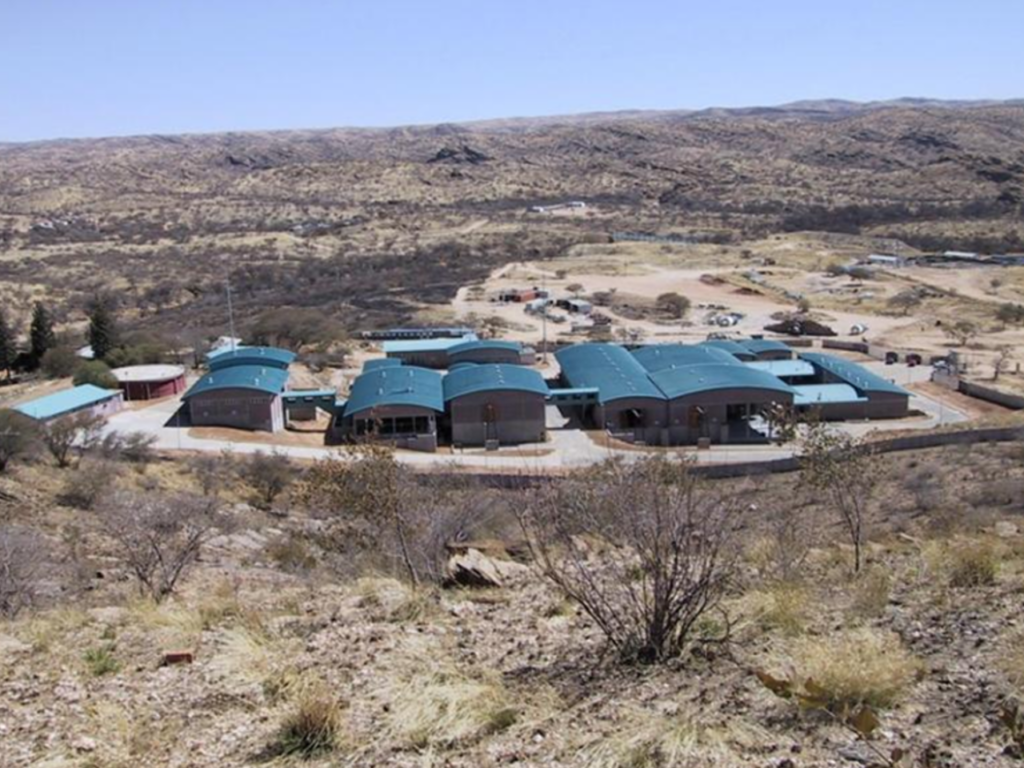
View of New Goreangab Drinking Water Reclamation Plant, Windhoek,
commissioned in 2002
During 1990 to 2000, Windhoek experienced a drought almost every two years. Ben van der Merwe, someone Menge identifies as a visionary, was the head of the Department of Water and Wastewater at the time. Van der Merwe was the driving force behind the planning of the New Goreangab Water Reclamation Plant (NGWRP) and numerous other projects, of which the managed aquifer recharge project became well known at a later stage.
“When all the research and planning started, we did not know that it would take another 10 years before finally building and commissioning the NGWRP. It was planned from the beginning, based on the initial investigations in 1991, that the reclamation process and extension of the plant’s capacity would be from 7 600 m
3 per day to 21 000 m
3 per day, with the limitations of existing infrastructure,” explains Menge.
During 1992 a report for the upgrade and extension of the old Goreangab Reclamation Works was compiled under the leadership of van der Merwe for the securing of international funding of the project. When the report was submitted to the KfW in 1993, the project was accepted to be funded with a loan of N$92 million (R92 million), with provision for contingencies of just over N$5 million. (N$1 = R1)
When the new plant had to go out on tender for building, another severe drought was looming. Due to water shortages the city could not afford to decommission the old plant for two years to do upgrades and extensions. Therefore, Mr Ben van der Merwe approached the previous funders of the plant – KfW – and the European Investment Bank (EIB) in 1999, to ask for permission to build a brand-new reclamation plant and to decommission the old Goreangab Water Reclamation Plant. Once the new plant started operating, the old plant would be used to reclaim wastewater for irrigation. Both the EIB and KfW decided to fund the construction of the new water reclamation plant, which was completed for N$125 million. At that time, there was a saying around the plant:
“You cannot fix an old bicycle with a new bell and pretend you are now driving a new bicycle.”
From the beginning of 1993 it was a clear mandate from the KfW, Windhoek could only receive capital if it implemented water saving measures. Water metering and residential water saving campaigns were used, as well as building a dual pipeline for semi-purified wastewater for irrigation. Furthermore, the operations of the plant had to be outsourced to a private company.
“The concept of privatisation was initially surprising, but in retrospect, it proved to be the best outcome for the plant. It protected the plant from the whims of politicians over the coming years. Reclamation is a risk-based process, and should anything go wrong, people can be harmed by parasites, viruses and bacteria,” states Menge. Under severe conditions, it can cause an epidemic.
The NGWRP was commissioned in 2002, replacing the 1968 facility. The 2002 NGWRP still stands and operates today.
International notoriety
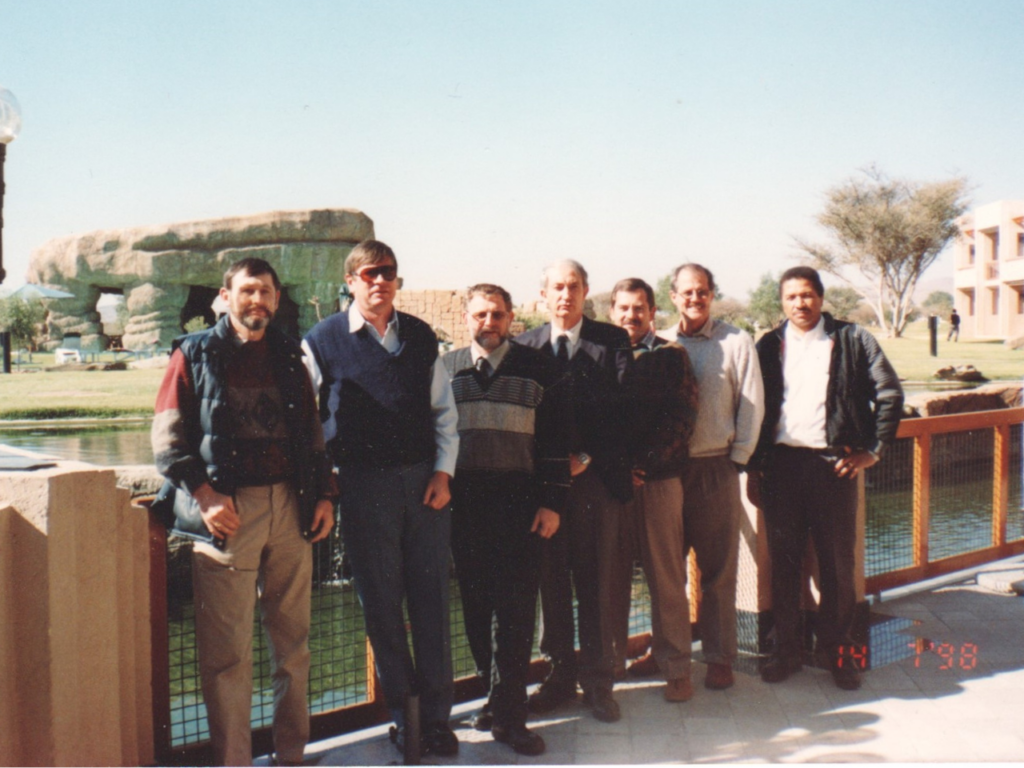
The senior water engineering team of the City of Windhoek during 1992 – 1998 (from left) Jürgen Menge, chief scientist; Immo Peters, Head of Water and Wastewater Operations; Ernst Gudde, Head of Mechanical Maintenance; Ben van der Merwe, Departmental Head of Water and Wastewater Engineering Services; Bertus Calitz, Head of Technical Design; Hannes Buckle , Head Water Resources and Demand Management; Ferdi Brinkman, Assistant Head Water and Wastewater Engineering Services
Jürgen has presented papers at conferences around the world, branding Windhoek as the first city in the world to have a direct potable reuse plant. He was even part of the delegation, headed by his boss Mr Piet du Pisani, that brought the International Water Association Reuse conference to Windhoek and showcased the NGWRP during 2013. Jürgen has also been part of various teams that have written guidelines for direct potable reclamation as well as papers on the alternatives to reverse osmosis in direct potable reuse. These efforts resulted in the international acceptance of the technology developed in Southern Africa using ozone-BAC-GAC as treatment barriers as an alternative to RO based reuse treatment elsewhere in the world.
While there has always been a focus on the technical risk of direct potable reuse, it needs to be done with a long-term view. “As time moves on, there is a new generation of scientists and engineers in place, overlooking water balances and plant operations. This is where education on a systems history is vitally important. We need to document the reason for certain processes in the plant, so that any changes made in future are done from an informed position and take these reasons into account.”
This is also the reason why it is an international recommendation to have an external advisory committee on board during the planning of a new potable reclamation scheme. Local engineering teams and mostly the consultants recruited for the design do not have the background for all the considerations and factors that need to be taken into account during design and often during commissioning.
Reclaimed water has relieved the pressure on Windhoek’s groundwater supplies. “Windhoek cannot survive without water reclamation. We have provided 55 years of data and evidence of safe practice that has helped convince regulators worldwide that direct potable reuse is a safe and economically viable long term augmentation option,” adds Menge.
With 47 years as a devoted water scientist and researcher in the water reuse field, Menge concludes: “Water was created to sustain life. We have a responsibility to manage it appropriately. Our current challenge as engineers and scientists is to view the full water cycle as a water supply source, which has the potential to sustain or threaten life. It is our responsibility to design, manage and render it fit for its intended purpose.”









